Sunghun Kim
Objectomaly: Objectness-Aware Refinement for OoD Segmentation with Structural Consistency and Boundary Precision
Jul 10, 2025Abstract:Out-of-Distribution (OoD) segmentation is critical for safety-sensitive applications like autonomous driving. However, existing mask-based methods often suffer from boundary imprecision, inconsistent anomaly scores within objects, and false positives from background noise. We propose \textbf{\textit{Objectomaly}}, an objectness-aware refinement framework that incorporates object-level priors. Objectomaly consists of three stages: (1) Coarse Anomaly Scoring (CAS) using an existing OoD backbone, (2) Objectness-Aware Score Calibration (OASC) leveraging SAM-generated instance masks for object-level score normalization, and (3) Meticulous Boundary Precision (MBP) applying Laplacian filtering and Gaussian smoothing for contour refinement. Objectomaly achieves state-of-the-art performance on key OoD segmentation benchmarks, including SMIYC AnomalyTrack/ObstacleTrack and RoadAnomaly, improving both pixel-level (AuPRC up to 96.99, FPR$_{95}$ down to 0.07) and component-level (F1$-$score up to 83.44) metrics. Ablation studies and qualitative results on real-world driving videos further validate the robustness and generalizability of our method. Code will be released upon publication.
KaSA: Knowledge-Aware Singular-Value Adaptation of Large Language Models
Dec 08, 2024Abstract:The increasing sizes of large language models (LLMs) result in significant computational overhead and memory usage when adapting these models to specific tasks or domains. Various parameter-efficient fine-tuning (PEFT) methods have been devised to mitigate these challenges by training a small set of parameters for the task-specific updates of the model weights. Among PEFT methods, LoRA stands out for its simplicity and efficiency, inspiring the development of a series of variants. However, LoRA and its successors disregard the knowledge that is noisy or irrelevant to the targeted task, detrimentally impacting model performance and leading to suboptimality. To address this limitation, we introduce Knowledge-aware Singular-value Adaptation (KaSA), a PEFT method that leverages singular value decomposition (SVD) with knowledge-aware singular values to dynamically activate knowledge based on its relevance to the task at hand. We conduct extensive experiments across a range of LLMs on tasks spanning natural language understanding (NLU), generation (NLG), instruction following, and commonsense reasoning. The experimental results demonstrate that KaSA consistently outperforms FFT and 14 popular PEFT baselines across 16 benchmarks and 4 synthetic datasets, underscoring our method's efficacy and adaptability. The source code of our method is available at https://github.com/juyongjiang/KaSA.
LlamaDuo: LLMOps Pipeline for Seamless Migration from Service LLMs to Small-Scale Local LLMs
Aug 24, 2024Abstract:The widespread adoption of cloud-based proprietary large language models (LLMs) has introduced significant challenges, including operational dependencies, privacy concerns, and the necessity of continuous internet connectivity. In this work, we introduce an LLMOps pipeline, "LlamaDuo", for the seamless migration of knowledge and abilities from service-oriented LLMs to smaller, locally manageable models. This pipeline is crucial for ensuring service continuity in the presence of operational failures, strict privacy policies, or offline requirements. Our LlamaDuo involves fine-tuning a small language model against the service LLM using a synthetic dataset generated by the latter. If the performance of the fine-tuned model falls short of expectations, it is enhanced by further fine-tuning with additional similar data created by the service LLM. This iterative process guarantees that the smaller model can eventually match or even surpass the service LLM's capabilities in specific downstream tasks, offering a practical and scalable solution for managing AI deployments in constrained environments. Extensive experiments with leading edge LLMs are conducted to demonstrate the effectiveness, adaptability, and affordability of LlamaDuo across various downstream tasks. Our pipeline implementation is available at https://github.com/deep-diver/llamaduo.
A Survey on Mixture of Experts
Jun 26, 2024Abstract:Large language models (LLMs) have garnered unprecedented advancements across diverse fields, ranging from natural language processing to computer vision and beyond. The prowess of LLMs is underpinned by their substantial model size, extensive and diverse datasets, and the vast computational power harnessed during training, all of which contribute to the emergent abilities of LLMs (e.g., in-context learning) that are not present in small models. Within this context, the mixture of experts (MoE) has emerged as an effective method for substantially scaling up model capacity with minimal computation overhead, gaining significant attention from academia and industry. Despite its growing prevalence, there lacks a systematic and comprehensive review of the literature on MoE. This survey seeks to bridge that gap, serving as an essential resource for researchers delving into the intricacies of MoE. We first briefly introduce the structure of the MoE layer, followed by proposing a new taxonomy of MoE. Next, we overview the core designs for various MoE models including both algorithmic and systemic aspects, alongside collections of available open-source implementations, hyperparameter configurations and empirical evaluations. Furthermore, we delineate the multifaceted applications of MoE in practice, and outline some potential directions for future research. To facilitate ongoing updates and the sharing of cutting-edge developments in MoE research, we have established a resource repository accessible at https://github.com/withinmiaov/A-Survey-on-Mixture-of-Experts.
GPT4Rec: Graph Prompt Tuning for Streaming Recommendation
Jun 12, 2024



Abstract:In the realm of personalized recommender systems, the challenge of adapting to evolving user preferences and the continuous influx of new users and items is paramount. Conventional models, typically reliant on a static training-test approach, struggle to keep pace with these dynamic demands. Streaming recommendation, particularly through continual graph learning, has emerged as a novel solution. However, existing methods in this area either rely on historical data replay, which is increasingly impractical due to stringent data privacy regulations; or are inability to effectively address the over-stability issue; or depend on model-isolation and expansion strategies. To tackle these difficulties, we present GPT4Rec, a Graph Prompt Tuning method for streaming Recommendation. Given the evolving user-item interaction graph, GPT4Rec first disentangles the graph patterns into multiple views. After isolating specific interaction patterns and relationships in different views, GPT4Rec utilizes lightweight graph prompts to efficiently guide the model across varying interaction patterns within the user-item graph. Firstly, node-level prompts are employed to instruct the model to adapt to changes in the attributes or properties of individual nodes within the graph. Secondly, structure-level prompts guide the model in adapting to broader patterns of connectivity and relationships within the graph. Finally, view-level prompts are innovatively designed to facilitate the aggregation of information from multiple disentangled views. These prompt designs allow GPT4Rec to synthesize a comprehensive understanding of the graph, ensuring that all vital aspects of the user-item interactions are considered and effectively integrated. Experiments on four diverse real-world datasets demonstrate the effectiveness and efficiency of our proposal.
Shortcut-connected Expert Parallelism for Accelerating Mixture-of-Experts
Apr 07, 2024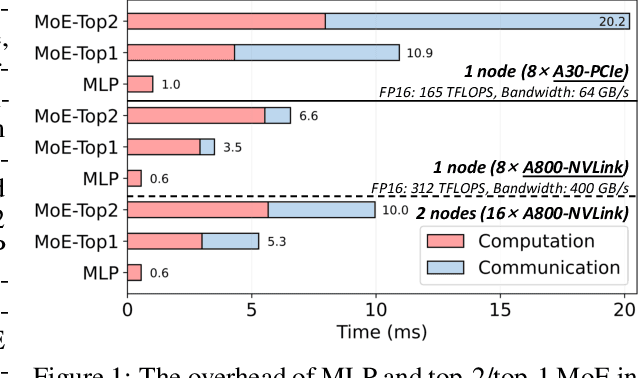
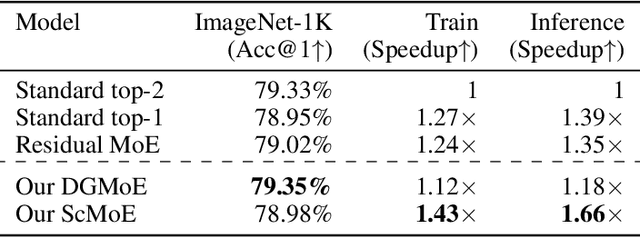
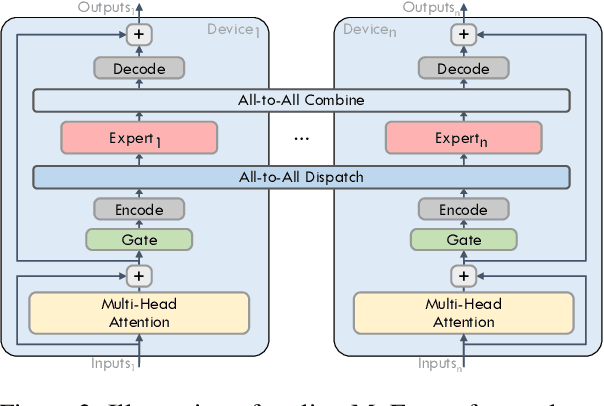
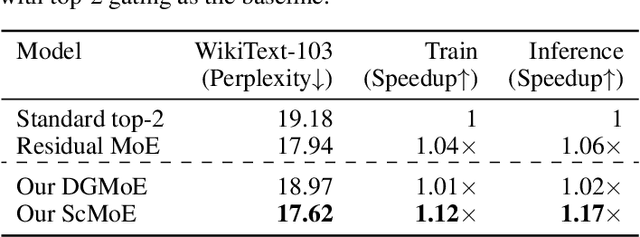
Abstract:Expert parallelism has been introduced as a strategy to distribute the computational workload of sparsely-gated mixture-of-experts (MoE) models across multiple computing devices, facilitating the execution of these increasingly large-scale models. However, the All-to-All communication intrinsic to expert parallelism constitutes a significant overhead, diminishing the MoE models' efficiency. Current optimization approaches offer some relief, yet they are constrained by the sequential interdependence of communication and computation operations. To address this limitation, we present a novel shortcut-connected MoE architecture with overlapping parallel strategy, designated as ScMoE, which effectively decouples communication from its conventional sequence, allowing for a substantial overlap of 70% to 100% with computation. When compared with the prevalent top-2 MoE architecture, ScMoE demonstrates training speed improvements of 30% and 11%, and inference improvements of 40% and 15%, in our PCIe and NVLink hardware environments, respectively, where communication constitutes 60% and 15% of the total MoE time consumption. On the other hand, extensive experiments and theoretical analyses indicate that ScMoE not only achieves comparable but in some instances surpasses the model quality of existing approaches in vision and language tasks.
Is Contrastive Learning Necessary? A Study of Data Augmentation vs Contrastive Learning in Sequential Recommendation
Mar 17, 2024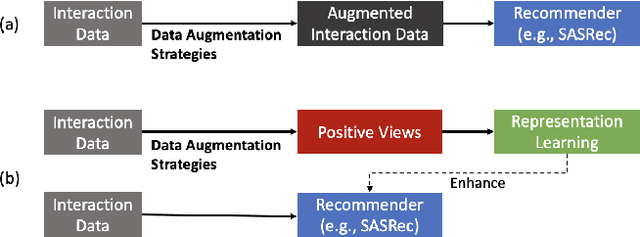
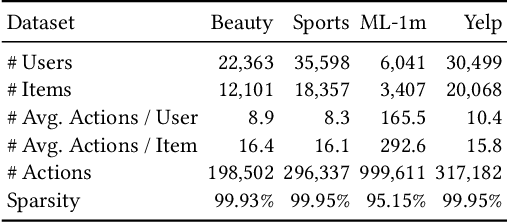


Abstract:Sequential recommender systems (SRS) are designed to predict users' future behaviors based on their historical interaction data. Recent research has increasingly utilized contrastive learning (CL) to leverage unsupervised signals to alleviate the data sparsity issue in SRS. In general, CL-based SRS first augments the raw sequential interaction data by using data augmentation strategies and employs a contrastive training scheme to enforce the representations of those sequences from the same raw interaction data to be similar. Despite the growing popularity of CL, data augmentation, as a basic component of CL, has not received sufficient attention. This raises the question: Is it possible to achieve superior recommendation results solely through data augmentation? To answer this question, we benchmark eight widely used data augmentation strategies, as well as state-of-the-art CL-based SRS methods, on four real-world datasets under both warm- and cold-start settings. Intriguingly, the conclusion drawn from our study is that, certain data augmentation strategies can achieve similar or even superior performance compared with some CL-based methods, demonstrating the potential to significantly alleviate the data sparsity issue with fewer computational overhead. We hope that our study can further inspire more fundamental studies on the key functional components of complex CL techniques. Our processed datasets and codes are available at https://github.com/AIM-SE/DA4Rec.
High-Frequency-aware Hierarchical Contrastive Selective Coding for Representation Learning on Text-attributed Graphs
Feb 26, 2024Abstract:We investigate node representation learning on text-attributed graphs (TAGs), where nodes are associated with text information. Although recent studies on graph neural networks (GNNs) and pretrained language models (PLMs) have exhibited their power in encoding network and text signals, respectively, less attention has been paid to delicately coupling these two types of models on TAGs. Specifically, existing GNNs rarely model text in each node in a contextualized way; existing PLMs can hardly be applied to characterize graph structures due to their sequence architecture. To address these challenges, we propose HASH-CODE, a High-frequency Aware Spectral Hierarchical Contrastive Selective Coding method that integrates GNNs and PLMs into a unified model. Different from previous "cascaded architectures" that directly add GNN layers upon a PLM, our HASH-CODE relies on five self-supervised optimization objectives to facilitate thorough mutual enhancement between network and text signals in diverse granularities. Moreover, we show that existing contrastive objective learns the low-frequency component of the augmentation graph and propose a high-frequency component (HFC)-aware contrastive learning objective that makes the learned embeddings more distinctive. Extensive experiments on six real-world benchmarks substantiate the efficacy of our proposed approach. In addition, theoretical analysis and item embedding visualization provide insights into our model interoperability.
SOLAR 10.7B: Scaling Large Language Models with Simple yet Effective Depth Up-Scaling
Dec 29, 2023



Abstract:We introduce SOLAR 10.7B, a large language model (LLM) with 10.7 billion parameters, demonstrating superior performance in various natural language processing (NLP) tasks. Inspired by recent efforts to efficiently up-scale LLMs, we present a method for scaling LLMs called depth up-scaling (DUS), which encompasses depthwise scaling and continued pretraining. In contrast to other LLM up-scaling methods that use mixture-of-experts, DUS does not require complex changes to train and inference efficiently. We show experimentally that DUS is simple yet effective in scaling up high-performance LLMs from small ones. Building on the DUS model, we additionally present SOLAR 10.7B-Instruct, a variant fine-tuned for instruction-following capabilities, surpassing Mixtral-8x7B-Instruct. SOLAR 10.7B is publicly available under the Apache 2.0 license, promoting broad access and application in the LLM field.
Can Transformer and GNN Help Each Other?
Aug 28, 2023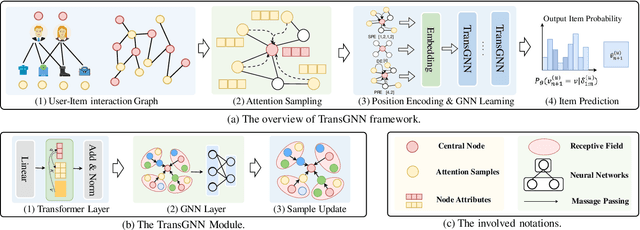


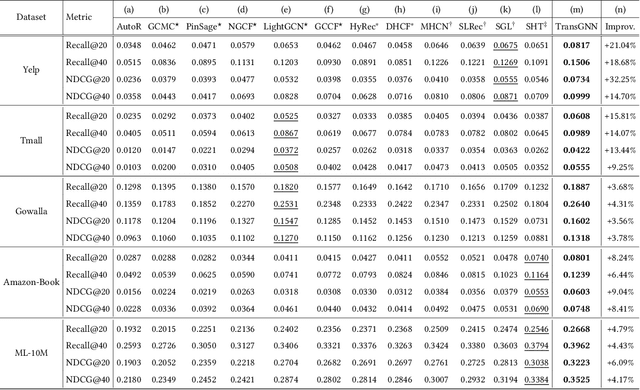
Abstract:Although Transformer has achieved great success in natural language process and computer vision, it has difficulty generalizing to medium and large-scale graph data for two important reasons: (i) High complexity. (ii) Failing to capture the complex and entangled structure information. In graph representation learning, Graph Neural Networks(GNNs) can fuse the graph structure and node attributes but have limited receptive fields. Therefore, we question whether can we combine Transformers and GNNs to help each other. In this paper, we propose a new model named TransGNN where the Transformer layer and GNN layer are used alternately to improve each other. Specifically, to expand the receptive field and disentangle the information aggregation from edges, we propose using Transformer to aggregate more relevant nodes' information to improve the message passing of GNNs. Besides, to capture the graph structure information, we utilize positional encoding and make use of the GNN layer to fuse the structure into node attributes, which improves the Transformer in graph data. We also propose to sample the most relevant nodes for Transformer and two efficient samples update strategies to lower the complexity. At last, we theoretically prove that TransGNN is more expressive than GNNs only with extra linear complexity. The experiments on eight datasets corroborate the effectiveness of TransGNN on node and graph classification tasks.
 Add to Chrome
Add to Chrome Add to Firefox
Add to Firefox Add to Edge
Add to Edge